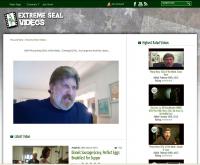DOES YOUR SITE CHASE POTENTIAL CUSTOMERS AWAY?
Imagine how difficult any creative task would be if
no two people saw things the same way. How could
you paint a wall knowing some people will see it as
beige, others as cream, and others as sepia?
This is exactly the task a professional web designer has to undertake. If colors were the only consideration, the job would be as easy as finding a 'middle ground' color scheme, which would please most of the people most of the time.
However, as with any profession, things are rarely as simple as they first appear.
Throw into the mix that people will see things either much larger or smaller than the designer created, and the challenge really begins.
The last thing a designer (or more importantly, his client) wants to have happen is the alienation of a potential customer, and yet this is something very few web designers seem to consider when creating a site.
How often have you visited a web site to find that it takes ages to load? Have you ever had to scroll across the page as well as down to see everything? How about a site that throws up a, 'you have to download this to view our site' message, and the download is going to take 15 minutes? Or, one of the most annoying things, have you sat and watched an animation that, after 2 minutes, still says 'loading flash intro'?
There is a very fine line between making a site an effective marketing tool for you, and not much more than a designer's ego trip. Some designers create huge flash animation intros with music and 3D dancing images. They throw in the works.
This is all well and good for your designer who is a
power user with a very high spec computer. However, the
normal viewing public, your potential customers, with slow
dial-up connections and/or normal home usage computers,
can't or won't wait for this to load to peruse your site.
As standard, we build our sites to the most common screen resolution, so over 90% of the people will be able to see the pages without scrolling sideways. We also build detection checks into our web sites.
We want to make sure that the visitor has everything necessary to fully experience the site. If they don't, we don't force them to go download anything. We simply build alternate versions of the page without the missing elements, and those pages are loaded instead. All this is done behind the scenes, and, in most cases, the viewer doesn't even know that it is happening. (This also comes under the area of 'user friendliness,' which I will cover next month).
With a great percentage of people still having 56k dial-up connections, loading speed has to be one of the primary considerations. When creating a site, the professional has to remember and adhere to the following:
A viewer will wait 30 seconds to see a photo they click, but they will not wait 4 minutes for a full page of only the larger pictures. Keep images to those needed. If there are a lot of photos, they should be made small and compressed to make them load faster. If the viewer wants to see the photos large, they should be made to click to larger versions. This way, those interested in seeing larger photos can without slowing down the load time for everyone else.
Images should also be scaled the exact size they will appear on the page. Many designers use HTML code to control the size an image is seen on screen. However, if the image is large, simply scaling down what is seen on the page will not reduce the time it takes to load. It will still take an age to load the full image, but will just display it smaller.
The 'safe color' palette should be used when creating images. This palette contains 216 very precise colors. Any deviation from these exact colors will result in the viewer seeing the closest color available. This is what has happened when you see boxes around images, usually logos, where the color just doesn't quite match.
Nowadays, with attention spans so short, any or all of the above can lose valuable potential clients. Keep all of these aspects in mind and consider different browsing software and screen sizes, and you have taken the first step in creating an efficient and enjoyable web site.
Next Month - Is your web site user friendly?
Date Published: 08/26/2003
Published By: Internet Marketing and Design
TrackBack URL:
http://internetmark.com/WebWorks_12_Does-your-site-chase-potential-customers-away
Terry Young on Google


